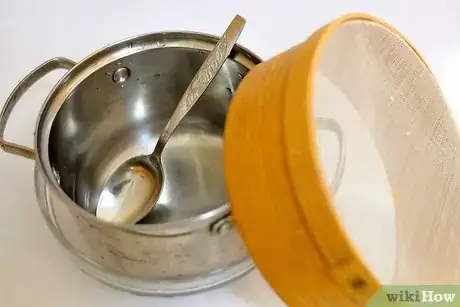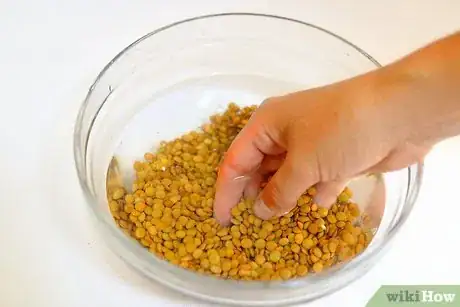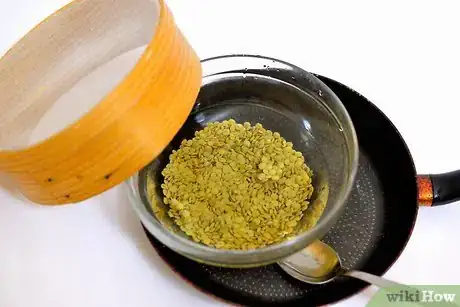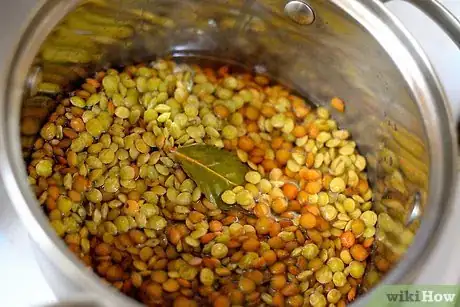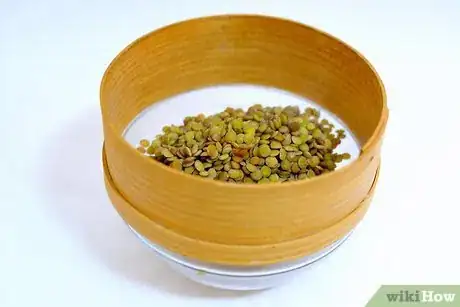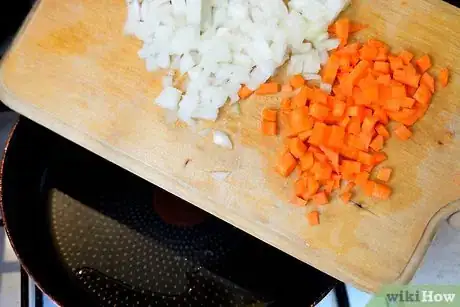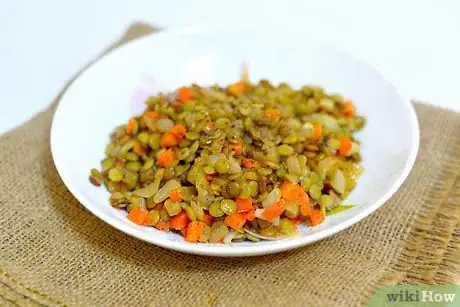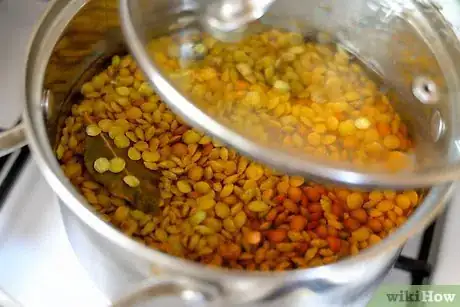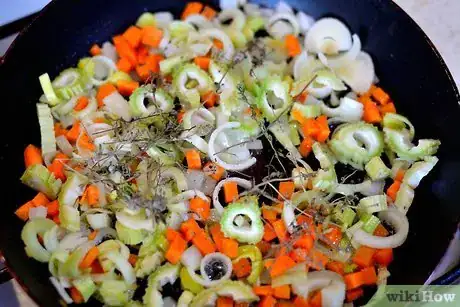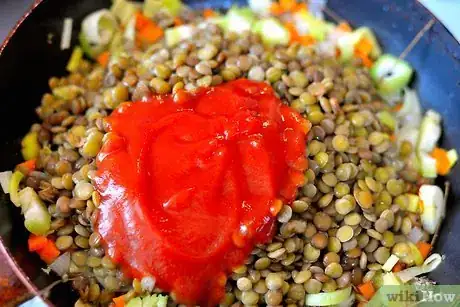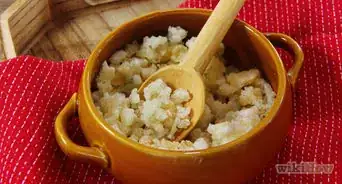This article was co-authored by wikiHow Staff. Our trained team of editors and researchers validate articles for accuracy and comprehensiveness. wikiHow's Content Management Team carefully monitors the work from our editorial staff to ensure that each article is backed by trusted research and meets our high quality standards.
wikiHow marks an article as reader-approved once it receives enough positive feedback. In this case, 85% of readers who voted found the article helpful, earning it our reader-approved status.
This article has been viewed 161,733 times.
Learn more...
Puy lentils are a specific variety of green lentil that come from a particular region in France. They have a flavor and color that are slightly distinct from other lentil varieties, and they also keep their shape much better when cooked. Because of the spicy flavor, nutty aroma, and hardy texture, Puy lentils are often eaten alone, added to salads, or made into soups.
Ingredients
Makes 4 Servings
- 1 cup (200 g) Puy lentils
- 2 cups (474 ml) water
- 1 bay leaf
- ½ teaspoon (3 g) salt
Makes 6 Servings
- 1¼ cup (250 g) Puy lentils
- Water, to cover
- 1 bay leaf
- 3 - 4 springs of fresh thyme
- Salt, to taste
- 1 tablespoon (15 ml) cooking oil
- 1 carrot, diced
- 1 medium onion, diced
- 1 fennel bulb, diced,
- Ground pepper, to taste
- 1 tablespoon (15 ml) red wine vinegar
- ¼ cup (59 ml) olive oil
- ⅛ teaspoon (0.65 g) Dijon mustard
- 1 small shallot, minced
Makes 8 to 10 Servings
- 2⅓ cups (467 g) Puy lentils
- Boiling water, to cover
- ¼ cup (59 ml) oil
- 3 large onions, chopped
- 3 garlic cloves, minced
- 2 large leeks, chopped
- Kosher salt, to taste
- Ground pepper, to taste
- 1 tablespoon (2 g) thyme
- 1 teaspoon (2 g) ground cumin
- 8 celery stalks, diced
- 6 carrots, diced
- 12 cups (2.8 L) broth
- ¼ cup (56 g) tomato paste
- 2 tablespoons (30 ml) red wine vinegar
- Parmesan cheese, for serving
Steps
Basic Stovetop Puy Lentils
-
1Gather your ingredients and supplies. Along with your ingredients, there are a few kitchen tools and supplies you'll need to make this simple lentil dish. The most important items are:
- Medium bowl
- Fine-mesh sieve
- Medium saucepan
- Stirring spoon
-
2Rinse and clean the lentils. Place the lentils into a medium bowl and fill it with enough water to cover the lentils. Use your hand to comb through the lentils. Pick out any organic debris or other matter that you find. When you’ve gone through the batch, drain the lentils through the sieve.
- While uncommon, there are sometimes pebbles or small stones hiding in lentils that can hurt or break teeth.[1]
Advertisement -
3Combine the ingredients. In a medium saucepan, combine the lentils and bay leaf. Add enough water to cover the lentils by about three inches (7.6 cm). To add extra flavor and depth to the lentils, you can also add other ingredients, such as:
- Herbs
- Spices
- Garlic
- Minced onions
-
4Cook the lentils. Put the lid on the pot and heat the lentils over medium-high heat. Bring the water to a simmer, and then reduce the heat to medium-low. Remove the lid and cook the lentils for about 25 minutes. Add more water as necessary to ensure the lentils stay covered.
- The lentils are ready when they are tender, and when there's no crunchiness left when you bite into them.[2]
-
5Strain and salt the lentils before serving. When the lentils are tender, remove the pot from the heat. Drain the water by pouring the lentils into the sieve. Return the lentils to the pot and add the salt. Stir to coat the lentils before serving.
- You can also garnish the lentils with other herbs and spices, such as pepper, rosemary, thyme, and sage.
Puy Lentil Salad
-
1Assemble your supplies and ingredients. Lentil salad is a basic dish that combines cooked lentils with spices, cooked vegetables, and a vinaigrette. Before starting, soak your lentils in water and pick out any rocks or organic matter that you find. Drain the lentils before cooking. You'll also need some supplies, including:[3]
- Medium saucepan
- Stirring spoon
- Frying pan
- Medium bowl
- Whisk
- Fine-mesh sieve
-
2Boil the lentils. Place the lentils into a medium saucepan with the bay leaf and thyme. Fill the pan with water so the lentils are under about three inches (7.6 cm) of water. Bring the pan to a boil over medium heat. When it boils, reduce the heat to low and add a pinch of salt. Continue simmering for 20 to 25 minutes.
- The lentils are ready as soon as they become tender. To test them, pick out a lentil with a spoon and crush it between your teeth. If it’s soft and easy to mash, the lentils are ready.[4]
-
3Drain the lentils. When the lentils are cooked and tender, remove them from the heat. Place your sieve in the sink, and carefully drain the lentils through to remove the excess water.
- Return the drained lentils to the saucepan. Place the lid back on and set them aside as you prepare the vegetables and vinaigrette.
-
4Cook the vegetables. In a large frying pan, combine the cooking oil, carrot, onion, and fennel. Season with salt and pepper, to taste. Heat the pan over medium heat, stirring regularly. Cook until the vegetables are tender, about 10 minutes.
- You can also add one to two cloves of crushed garlic to the mixture as well.[5]
- Reserve the minced shallot, which will be used in the vinaigrette.
-
5Make the vinaigrette. In a medium bowl, combine the red wine vinegar, olive oil, and mustard. Whisk them together until the vinaigrette starts to thicken. Whisk in the minced shallot.[6]
- Dijon mustard is recommended for this dish, but you can use any type of mustard you like.
-
6Toss the ingredients together. Combine the cooked vegetables, lentils, and vinaigrette together in the saucepan you cooked the lentils in. Stir to incorporate everything and coat the lentils and vegetables in the dressing.
- As you stir the ingredients together, pick out the bay leaf and thyme that you cooked with the lentils.
-
7Serve the salad warm. Allow the salad to cool to warm or room temperature before serving. You can drizzle some olive oil over the finished dish if you like, and season with more salt and pepper, to taste.
- You can also let the lentils cool completely and toss them with lettuce or chopped fresh herbs. Good herb pairings include thyme, savory, and parsley.
Puy Lentil Soup
-
1Soak the lentils. Pour the lentils into a heat-safe bowl and add enough boiling water to cover them by an inch (2.5 cm). Set the bowl aside and let the lentils soak in the boiling water for about 15 minutes.
- This will par-cook the lentils so they’ll be tender when the soup is done.[7]
-
2Cook the vegetables and spices. Pour the oil into a large stockpot and heat it over medium heat for two minutes. Add the onion, garlic, leek, salt and pepper (to taste), thyme, and cumin. Cook the vegetables and spices for about 20 minutes, stirring regularly.
- When the onions and leeks are tender, add the celery and carrots. Cook for another 10 minutes, stirring regularly.[8]
-
3Cook together with the stock, paste, and lentils. Strain the lentils and add them to the pot with the vegetables and spices. Add the stock and the tomato paste, and stir to combine all the ingredients. Put on the lid and bring the mixture to a boil over high heat. When the soup boils, reduce the heat to medium and remove the lid.
- Let the soup simmer on medium heat for an hour, until the lentils are tender. Stir the soup every 15 minutes to prevent burning.[9]
-
4Add the red wine vinegar and seasoning. When the lentils are tender, add the final ingredient. Taste the soup, and add more salt and pepper, to taste. You can also use an immersion blender to puree a quarter of the soup and give it a thicker consistency.[10]
- To use a blender, transfer about 2 cups of the soup to a blender. Puree the soup and stir it back in with the rest of the pot.
-
5Garnish with Parmesan and serve hot. Serve the soup as soon as you’ve seasoned it to your liking. You can drizzle each serving with a bit of olive oil if you like, and garnish the top of each bowl with some freshly grated Parmesan cheese.[11]
Community Q&A
-
QuestionWhat are Puy lentils called in the dried form?
 Community AnswerLentils are a member of the legume family, along with chickpeas, beans, and peas. Lentils are grown for their edible seeds. When these seeds are in a dried form, they're referred to as pulse. Pulses must generally be soaked or cooked before they can be eaten, and they are high in protein, fiber, and other vitamins and minerals.
Community AnswerLentils are a member of the legume family, along with chickpeas, beans, and peas. Lentils are grown for their edible seeds. When these seeds are in a dried form, they're referred to as pulse. Pulses must generally be soaked or cooked before they can be eaten, and they are high in protein, fiber, and other vitamins and minerals.
References
- ↑ http://www.bonappetit.com/test-kitchen/common-mistakes/article/5-common-mistakes-people-make-cooking-lentils
- ↑ http://www.thekitchn.com/how-to-cook-lentils-on-the-stove-116321
- ↑ http://www.seriouseats.com/recipes/2010/09/basic-french-lentils-recipe.html
- ↑ http://www.davidlebovitz.com/cheap-caviar-1/
- ↑ http://www.seriouseats.com/recipes/2010/09/basic-french-lentils-recipe.html
- ↑ http://www.davidlebovitz.com/cheap-caviar-1/
- ↑ http://www.foodandwine.com/recipes/french-lentil-and-vegetable-soup
- ↑ http://www.onceuponachef.com/2013/01/french-lentil-and-vegetable-soup-with-bacon.html
- ↑ http://www.foodandwine.com/recipes/french-lentil-and-vegetable-soup
